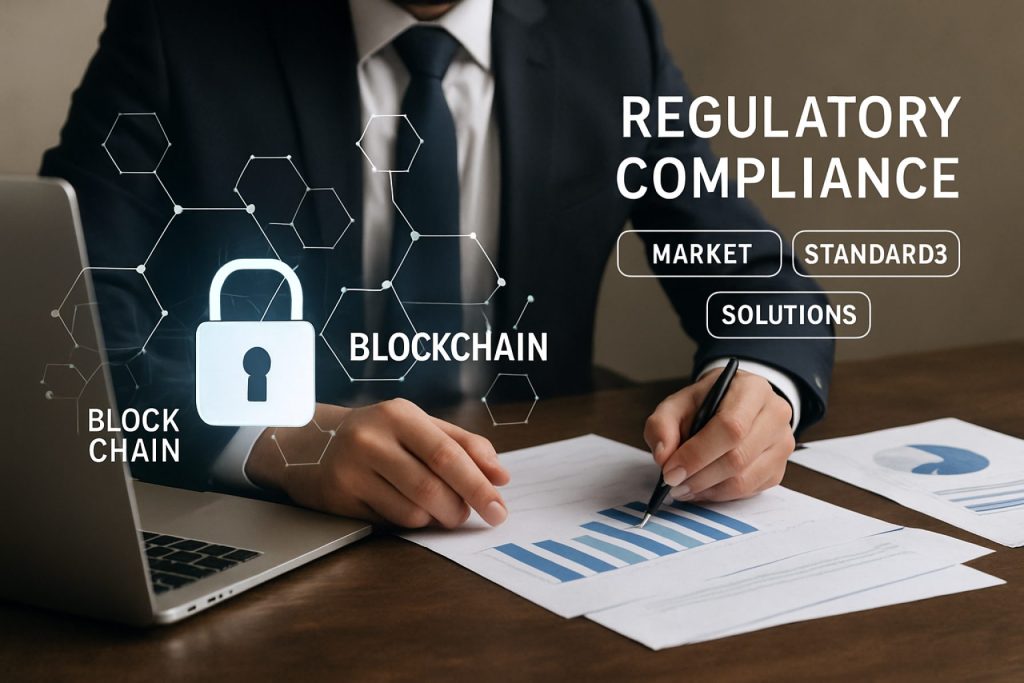
Blockchain Regulatory Compliance Solutions Market Report 2025: In-Depth Analysis of Growth Drivers, Technology Innovations, and Global Regulatory Shifts. Discover Key Trends, Forecasts, and Strategic Opportunities Shaping the Industry.
- Executive Summary and Market Overview
- Key Technology Trends in Blockchain Regulatory Compliance
- Competitive Landscape and Leading Solution Providers
- Market Growth Forecasts and Revenue Projections (2025–2030)
- Regional Analysis: Adoption and Regulatory Developments by Geography
- Future Outlook: Emerging Standards and Strategic Roadmaps
- Challenges, Risks, and Opportunities in Blockchain Compliance
- Sources & References
Executive Summary and Market Overview
Blockchain regulatory compliance solutions are specialized technologies and services designed to help organizations operating in the blockchain and cryptocurrency sectors adhere to evolving legal and regulatory requirements. As the global blockchain market matures, regulatory scrutiny has intensified, particularly around anti-money laundering (AML), know-your-customer (KYC), and data privacy mandates. In 2025, the demand for robust compliance solutions is accelerating, driven by both the proliferation of decentralized finance (DeFi) platforms and the increasing adoption of digital assets by mainstream financial institutions.
According to Gartner, worldwide blockchain spending is projected to reach $19 billion in 2024, with a significant portion allocated to compliance and risk management tools. This trend is expected to continue into 2025 as regulatory bodies such as the U.S. Securities and Exchange Commission (SEC), Swiss Financial Market Supervisory Authority (FINMA), and the European Securities and Markets Authority (ESMA) introduce more comprehensive frameworks for digital assets and blockchain-based services.
Key market drivers include the implementation of the European Union’s Markets in Crypto-Assets Regulation (MiCA), which comes into full effect in 2025, and the expansion of the Financial Action Task Force (FATF) Travel Rule to cover a broader range of virtual asset service providers (VASPs). These regulations require enhanced transaction monitoring, identity verification, and reporting capabilities, fueling demand for advanced compliance platforms from providers such as Chainalysis, Elliptic, and TRM Labs.
- Financial institutions are increasingly integrating blockchain compliance solutions to facilitate secure onboarding, transaction screening, and real-time risk assessment.
- DeFi protocols and NFT marketplaces are adopting automated compliance tools to mitigate regulatory risks and attract institutional capital.
- RegTech startups are innovating with AI-driven analytics, cross-chain monitoring, and privacy-preserving compliance mechanisms.
In summary, the blockchain regulatory compliance solutions market in 2025 is characterized by rapid growth, technological innovation, and heightened regulatory expectations. Organizations that proactively invest in compliance infrastructure are better positioned to capitalize on blockchain’s transformative potential while minimizing legal and reputational risks.
Key Technology Trends in Blockchain Regulatory Compliance
Blockchain regulatory compliance solutions are rapidly evolving to address the increasing complexity of global regulations and the growing adoption of blockchain technologies across industries. In 2025, these solutions are characterized by advanced automation, interoperability, and integration with both on-chain and off-chain data sources, enabling organizations to meet stringent compliance requirements efficiently.
One of the most significant trends is the rise of automated Know Your Customer (KYC) and Anti-Money Laundering (AML) protocols embedded directly into blockchain platforms. Solutions such as Chainalysis and TRM Labs leverage machine learning and real-time analytics to monitor transactions, flag suspicious activities, and generate compliance reports that align with evolving regulatory frameworks. These platforms are increasingly integrating with decentralized finance (DeFi) protocols, providing compliance layers without compromising the core principles of decentralization.
Another key trend is the adoption of zero-knowledge proofs (ZKPs) and privacy-preserving technologies. These allow for the verification of compliance-related information—such as user identity or transaction legitimacy—without exposing sensitive data on public ledgers. Companies like ZKProof are pioneering standards that enable regulatory compliance while maintaining user privacy, a critical requirement in jurisdictions with strict data protection laws.
Interoperability is also a focal point, as organizations seek solutions that can operate across multiple blockchains and legacy systems. Platforms such as R3 and Hyperledger are developing frameworks that facilitate seamless data exchange and compliance checks across diverse networks, reducing operational silos and enhancing regulatory reporting capabilities.
Regulatory technology (RegTech) providers are increasingly offering compliance-as-a-service models, enabling businesses to outsource complex compliance functions. These services are often cloud-based, scalable, and updated in real time to reflect regulatory changes, as seen with offerings from Elliptic and ComplyAdvantage.
Finally, the integration of artificial intelligence (AI) and natural language processing (NLP) is streamlining the interpretation of regulatory texts and automating the mapping of requirements to blockchain operations. This reduces manual effort and ensures that compliance solutions remain aligned with the latest legal developments worldwide, as highlighted in recent analyses by Gartner and IDC.
Competitive Landscape and Leading Solution Providers
The competitive landscape for blockchain regulatory compliance solutions in 2025 is characterized by rapid innovation, increased regulatory scrutiny, and a growing number of specialized providers. As governments and financial authorities worldwide tighten oversight of digital assets, demand for robust compliance tools has surged, particularly in areas such as anti-money laundering (AML), know-your-customer (KYC), transaction monitoring, and reporting. This has led to a dynamic market where established technology firms, blockchain-native startups, and traditional compliance vendors compete to deliver comprehensive, scalable, and adaptable solutions.
Leading solution providers in this space include:
- Chainalysis: Renowned for its blockchain analytics and investigation tools, Chainalysis offers solutions that help financial institutions, exchanges, and regulators monitor transactions, identify illicit activity, and ensure compliance with global AML and counter-terrorism financing (CTF) regulations.
- TRM Labs: TRM Labs provides a suite of compliance and risk management tools, including wallet screening, transaction monitoring, and forensic investigation, tailored for both crypto-native and traditional financial institutions.
- Elliptic: Elliptic specializes in blockchain analytics, offering solutions for transaction screening, wallet risk scoring, and regulatory reporting, with a strong focus on supporting compliance with evolving global standards.
- ComplyAdvantage: While not exclusively blockchain-focused, ComplyAdvantage has expanded its offerings to include crypto transaction monitoring and risk assessment, leveraging AI-driven data analytics to support compliance teams.
- IdentityMind (acquired by Acuant): IdentityMind delivers digital identity verification and KYC solutions, increasingly integrated with blockchain platforms to streamline onboarding and ongoing compliance.
In addition to these leaders, the market is witnessing the entry of major cloud providers and enterprise software companies, such as IBM and Microsoft, which are embedding compliance modules into their blockchain-as-a-service (BaaS) offerings. This trend is intensifying competition and driving consolidation, as larger players acquire innovative startups to expand their capabilities.
Key competitive differentiators in 2025 include the breadth of supported blockchains, integration with traditional financial systems, real-time analytics, and the ability to adapt to rapidly changing regulatory requirements. As regulatory frameworks mature, solution providers that can offer global coverage, automation, and seamless user experiences are expected to gain further market share. According to Gartner, the market for blockchain compliance solutions is projected to grow at a double-digit CAGR through 2027, underscoring the strategic importance of this sector.
Market Growth Forecasts and Revenue Projections (2025–2030)
The market for blockchain regulatory compliance solutions is poised for robust growth in 2025, driven by increasing regulatory scrutiny, the proliferation of digital assets, and the expanding adoption of blockchain technology across financial services, supply chains, and other sectors. According to Gartner, global spending on blockchain solutions is expected to surpass $19 billion in 2024, setting the stage for significant investment in compliance-focused platforms in 2025.
Revenue projections for blockchain regulatory compliance solutions in 2025 indicate a market size of approximately $3.2 billion, with a compound annual growth rate (CAGR) forecasted at 21–25% through 2030, according to MarketsandMarkets and Grand View Research. This growth is underpinned by the increasing complexity of anti-money laundering (AML), know-your-customer (KYC), and data privacy regulations, particularly in North America and Europe, where regulatory bodies such as the U.S. Securities and Exchange Commission and the European Securities and Markets Authority are intensifying oversight of digital asset activities.
Key drivers for 2025 include:
- Implementation of the European Union’s Markets in Crypto-Assets (MiCA) regulation, which will require comprehensive compliance infrastructure for crypto service providers.
- Expansion of the Financial Action Task Force (FATF) Travel Rule, compelling virtual asset service providers to adopt advanced transaction monitoring and reporting tools.
- Growing demand from institutional investors for transparent, auditable, and compliant blockchain solutions, especially in decentralized finance (DeFi) and tokenized assets.
Leading vendors such as Chainalysis, Elliptic, and TRM Labs are expected to capture significant market share by expanding their product suites to address evolving regulatory requirements and integrating artificial intelligence for real-time risk assessment. The Asia-Pacific region is also projected to see accelerated adoption, particularly in Singapore and Japan, as local regulators introduce clearer frameworks for blockchain compliance.
Overall, 2025 will mark a pivotal year for blockchain regulatory compliance solutions, with revenue growth fueled by both regulatory mandates and the strategic imperative for organizations to mitigate compliance risks in an increasingly digital financial ecosystem.
Regional Analysis: Adoption and Regulatory Developments by Geography
The adoption and regulatory landscape for blockchain compliance solutions in 2025 is marked by significant regional variation, shaped by local legal frameworks, enforcement priorities, and the pace of digital asset market development. As governments and regulatory bodies intensify their scrutiny of blockchain-based activities, the demand for robust compliance solutions—spanning anti-money laundering (AML), know-your-customer (KYC), transaction monitoring, and reporting—continues to surge globally.
North America remains at the forefront, driven by proactive regulatory measures and high institutional adoption. The Financial Industry Regulatory Authority (FINRA) and the U.S. Securities and Exchange Commission (SEC) have issued updated guidance on digital asset compliance, prompting financial institutions and crypto service providers to integrate advanced blockchain analytics and compliance platforms. The U.S. Treasury’s Financial Crimes Enforcement Network (FinCEN) has also expanded its requirements for virtual asset service providers (VASPs), accelerating the uptake of automated compliance tools.
In Europe, the implementation of the Markets in Crypto-Assets (MiCA) Regulation and the FATF Travel Rule has catalyzed the adoption of compliance solutions among exchanges and custodians. The region’s focus on harmonized standards and cross-border interoperability has led to increased demand for solutions that can adapt to multi-jurisdictional requirements. Major financial hubs such as Germany, France, and Switzerland are witnessing rapid integration of blockchain compliance platforms, as local regulators enforce stricter reporting and transparency obligations.
Asia-Pacific presents a diverse regulatory environment. Jurisdictions like Singapore and Japan have established clear licensing regimes for digital asset businesses, fostering a competitive market for compliance technology providers. The Monetary Authority of Singapore (MAS) and the Financial Services Agency of Japan (FSA) have both mandated robust AML/KYC controls, driving adoption of blockchain compliance solutions. Conversely, China’s restrictive stance on crypto trading has limited the market, though blockchain technology for enterprise compliance remains a focus.
- Latin America is experiencing growing adoption, particularly in Brazil and Mexico, where evolving regulations and increased crypto activity are prompting exchanges to deploy compliance platforms.
- Middle East and Africa are emerging markets, with the Abu Dhabi Global Market (ADGM) and Financial Services Regulatory Authority (FSRA) leading regional regulatory innovation and compliance adoption.
Overall, 2025 is characterized by a global convergence toward stricter regulatory oversight, with regional nuances shaping the pace and nature of blockchain compliance solution adoption.
Future Outlook: Emerging Standards and Strategic Roadmaps
The future outlook for blockchain regulatory compliance solutions in 2025 is shaped by the rapid evolution of global standards and the strategic alignment of industry players with emerging regulatory frameworks. As blockchain adoption accelerates across financial services, supply chains, and digital identity management, regulatory bodies are intensifying efforts to harmonize compliance requirements, particularly around anti-money laundering (AML), know-your-customer (KYC), and data privacy.
In 2025, the Financial Action Task Force (FATF) is expected to further refine its guidance on the “Travel Rule,” compelling virtual asset service providers (VASPs) to enhance information sharing and transaction monitoring. This is driving solution providers to develop interoperable compliance tools that can seamlessly integrate with both legacy systems and decentralized platforms. The European Union’s Markets in Crypto-Assets Regulation (European Parliament) and the U.S. Securities and Exchange Commission’s (U.S. Securities and Exchange Commission) evolving stance on digital assets are also setting benchmarks for global compliance, prompting vendors to prioritize cross-jurisdictional adaptability in their product roadmaps.
Strategically, leading compliance solution providers are investing in AI-driven analytics, privacy-preserving technologies (such as zero-knowledge proofs), and blockchain interoperability protocols. These innovations aim to automate regulatory reporting, enhance real-time risk assessment, and ensure data minimization in line with the General Data Protection Regulation (European Commission). Industry consortia, such as the R3 and Hyperledger Foundation, are collaborating to establish open standards for compliance APIs and smart contract auditing, fostering a more unified compliance ecosystem.
- By 2025, market analysts project that over 60% of blockchain compliance solutions will offer modular, API-first architectures to support rapid regulatory updates and integration with RegTech platforms (Gartner).
- Strategic partnerships between blockchain analytics firms and traditional financial institutions are expected to proliferate, enabling more robust transaction monitoring and fraud detection capabilities (Chainalysis).
- Emerging standards from organizations like the International Organization for Standardization (ISO/TC 307) will further drive interoperability and best practices in compliance solution development.
In summary, the 2025 landscape for blockchain regulatory compliance solutions will be defined by the convergence of global standards, technological innovation, and strategic industry collaboration, positioning the sector for scalable, adaptive, and future-proof compliance frameworks.
Challenges, Risks, and Opportunities in Blockchain Compliance
As blockchain adoption accelerates across industries in 2025, regulatory compliance remains a critical concern for enterprises and financial institutions. Blockchain regulatory compliance solutions are evolving rapidly to address the complex, shifting landscape of global regulations, but they face significant challenges and risks while also presenting substantial opportunities.
Challenges and Risks
- Fragmented Regulatory Landscape: The lack of harmonized global standards creates uncertainty for blockchain projects operating across borders. Jurisdictions such as the European Union, United States, and Asia-Pacific each have distinct requirements for anti-money laundering (AML), know-your-customer (KYC), and data privacy, complicating compliance efforts for multinational organizations (Deloitte).
- Rapid Regulatory Evolution: Regulatory frameworks for digital assets and blockchain are evolving quickly, with new guidance and enforcement actions emerging regularly. This dynamic environment increases the risk of non-compliance and necessitates continuous monitoring and adaptation of compliance solutions (PwC).
- Technical Complexity: Integrating compliance tools with decentralized networks and smart contracts presents technical hurdles. Ensuring that compliance solutions are interoperable with various blockchain protocols and legacy systems is a persistent challenge (IBM).
- Privacy vs. Transparency: Balancing the transparency inherent in blockchain with privacy requirements (such as GDPR) is a nuanced challenge. Solutions must enable regulatory reporting without exposing sensitive user data (EU Blockchain Observatory & Forum).
Opportunities
- Automated Compliance: The integration of AI and machine learning with blockchain compliance tools enables real-time monitoring, anomaly detection, and automated reporting, reducing manual workloads and improving accuracy (Accenture).
- RegTech Innovation: The rise of regulatory technology (RegTech) startups focused on blockchain is fostering new solutions for identity verification, transaction monitoring, and regulatory reporting, creating a competitive and innovative market (Deloitte).
- Standardization Initiatives: Industry consortia and standards bodies are working to develop interoperable compliance frameworks, which could streamline cross-border operations and reduce compliance costs in the long term (International Organization for Standardization (ISO)).
In summary, while blockchain regulatory compliance solutions in 2025 face significant hurdles due to regulatory fragmentation, technical complexity, and privacy concerns, they also offer transformative opportunities for automation, innovation, and global standardization.
Sources & References
- European Securities and Markets Authority (ESMA)
- Chainalysis
- Elliptic
- TRM Labs
- ZKProof
- Hyperledger
- IDC
- IdentityMind
- IBM
- MarketsandMarkets
- Grand View Research
- Financial Industry Regulatory Authority (FINRA)
- Financial Crimes Enforcement Network (FinCEN)
- Markets in Crypto-Assets (MiCA) Regulation
- Monetary Authority of Singapore (MAS)
- Financial Services Agency of Japan (FSA)
- Abu Dhabi Global Market (ADGM)
- European Commission
- International Organization for Standardization (ISO/TC 307)
- Deloitte
- PwC
- Accenture



